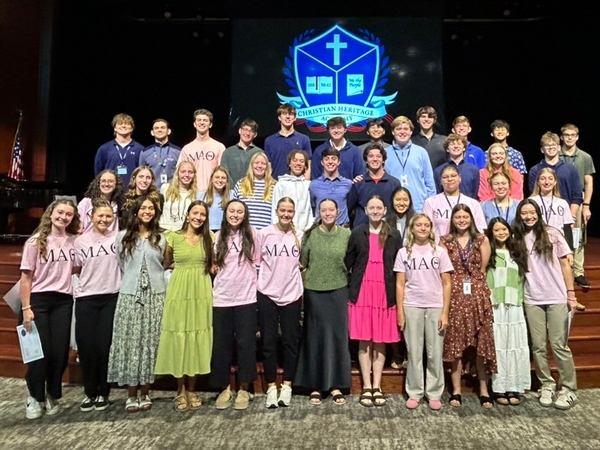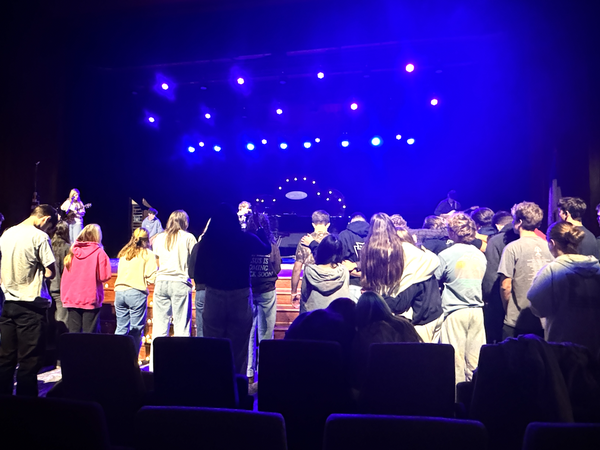Blog
Distinctively CHA
More Than Math

Mu Alpha Theta is a national math honor society. Students who have completed at least two years of high school mathematics and received an A or B in four semesters are eligible to join. Clubs are CHA are designed to train student leaders. MAO officers organize weekly free tutoring opportunities, plan club meetings, host Pi Week, and decorate secondary bulletin boards. Recently, MAO held its fifteenth annual induction ceremony. During the induction ceremony, Eli Steelman, the vice president, shared a charge with MAO members. Here is an excerpt.
"The foundations of mathematics echo the objective truth of the Lord. God is consistent, unchanging, and trustworthy, and truth ultimately comes from Him. John 14:6 says, “Jesus said to him, ‘I am the way, and the truth, and the life. No one comes to the Father except through me.’” Hebrews 13:8 reminds us that “Jesus Christ is the same yesterday and today and forever.” From the very beginning of Scripture, order is displayed, in the numbered days of creation or the order in which He created all things. God’s precision is also seen in constants such as the speed of light and gravitational force. If even one value within this design were off, the stars wouldn’t shine, the planets wouldn’t orbit… life wouldn’t exist. As Leonhard Euler once said, “For since the fabric of the universe is most perfect and the work of a most wise Creator, nothing at all takes place in the universe in which some rule of maximum or minimum does not appear…”
“Mu Alpha Theta may be an international math honor society, but at Christian Heritage Academy, it is more than just a club. Whether you aspire to become an engineer, architect, accountant, math teacher, or pursue a different calling altogether, it is critical that we recognize how God’s sovereignty can be seen in all areas of life—even in something as simple as 1 + 1. As we move forward, I encourage you all to remember the purpose and mission of our role in Mu Alpha Theta. Let us bring glory and honor to God through how we teach, how we serve, and how diligently we commit ourselves to this club.”
One of CHA’s distinctives is our Principle Approach methodology, which teaches every subject from God’s Word. Each subject is a platform for the gospel. It is indeed—more than math.
Seek First

Last Thursday night, student council, under the leadership of student council chaplain Joy Washa, hosted a Seek First worship event. The student leaders coordinated the food truck, outside games, guest speaker, band, and program. It was a beautiful example of CHA’s vision of producing leaders in every sphere of society.
The purpose of the evening was to gather with other believers and proclaim the gospel. Students voluntarily met at lunch on the preceding Tuesday and Thursday to discuss how to share the gospel. Students gathered to pray for the event and ask the Lord to “seek and to save” those who are lost. Some students from Del City High School were invited to attend the event.
Student leaders were gracious hosts. There was free hot cocoa and fruit. The students leading worship were prepared and skilled. At the event, one student from Del City High School gave his life to Christ.
As we approach the busyness of the holiday season, let us not forget to seek Christ first…
- Daily in our quiet times
- Corporately with our churches in small accountability groups and worship services
- Intentionally with our time, talents, and resources.
“Therefore, do not be anxious, saying, ‘What shall we eat?’ or ‘What shall we drink?’ or ‘What shall we wear?’ For the Gentiles seek after all these things, and your heavenly Father knows that you need them all. But seek first the kingdom of God and his righteousness, and all these things will be added to you.”—Matthew 6:31–33
What is stealing first? May we seek Him.
Pressed Down & Overflowing

The other day, I was walking down the hall in the elementary school and came across a beautiful display. I was taken aback by the color, the diversity, and the enormity. Each fruit opens up, and the students have written a note of gratitude. If you are in the building, I encourage you to stop and admire the students’ work.
We indeed have an abundance of reasons to be thankful. I am thankful for our faculty and their commitment to Principle Approach education, which is seen in their investment in our students, partnership with our families, and unseen hours of grading and preparation. I am thankful to our coaches and all the countless hours they have invested in our athletes. I am grateful for our staff and the selfless support that they supply each and every day to our faculty, administrators, and parents. I am thankful for our parents and the sacrifice that they make to allow their students to attend CHA. I am thankful for our students and the joy that they bring with their creativity and eagerness to learn.
“Give, and it will be given to you. Good measure, pressed down, shaken together, running over, will be put into your lap. For with the measure you use, it will be measured back to you.”—Luke 6:38
I am grateful for the Lord’s mercy in allowing me to serve at Christian Heritage Academy. For what or whom are you thankful? Tell them this week.
Have a great week.
